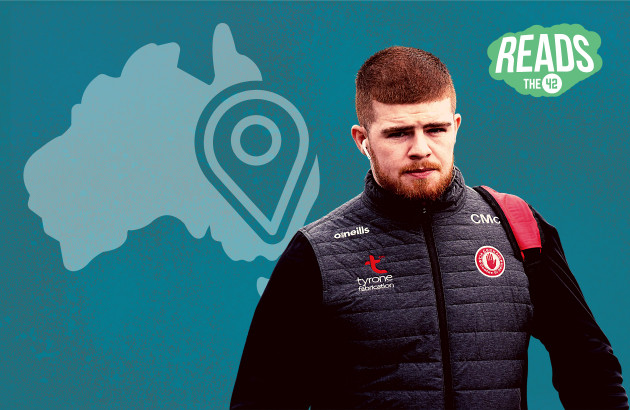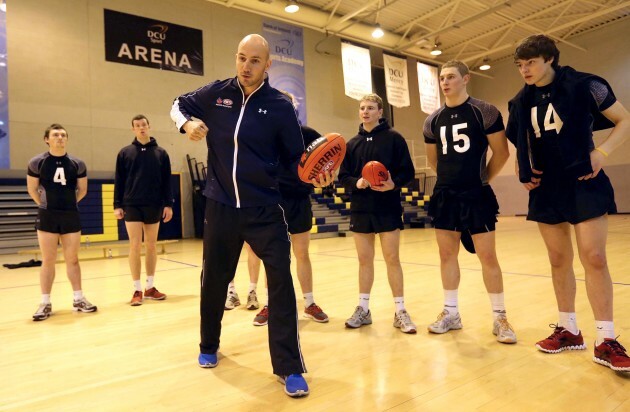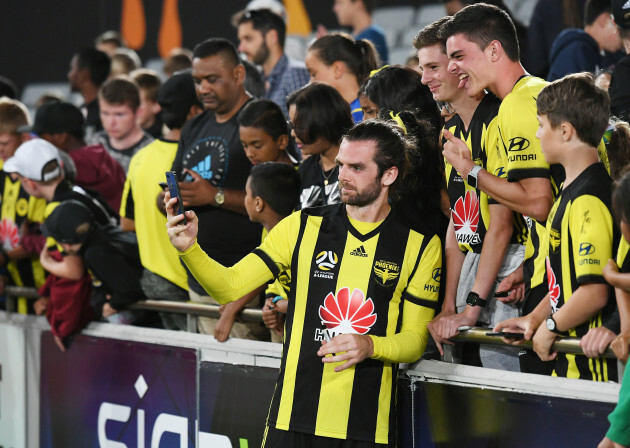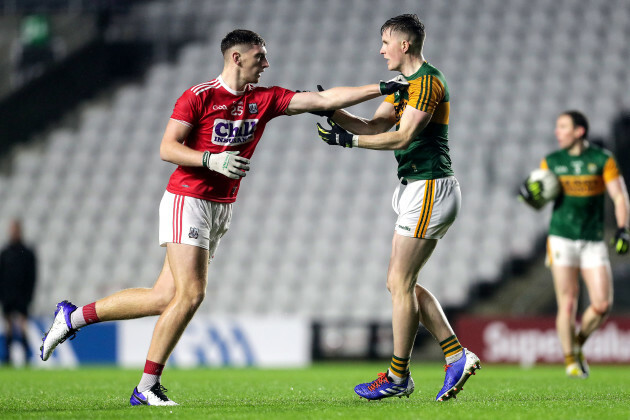WHAT COULD HAVE been for the AFL? In different circumstances, Conor McKenna and Cathal McShane would be Down Under helping with Essendon and Adelaide’s hunt for a spot in the top eight.
As it is, both outfits are likely to miss the cut while Tyrone’s duo will lead the forward line today as they begin their search for a first provincial title since 2017.
It was the beginning of 2020 when the Crows came knocking on the full-forward’s door. Eight months later, McShane had turned down a two-year contract offer while McKenna, his former minor team-mate, had retired from the game.
Both of their dealings are more than just a ‘what if?’ In reality, they reveal much about the AFL’s recruitment process, and why it will continue in the coming years.
- For more great storytelling and analysis from our award-winning journalists, join the club at The42 Membership today. Click here to find out more >
It was 2019 when McShane blossomed on the national stage. His championship tally stood at 3-48, he won an All-Star at full forward and energised Tyrone’s attack. Yet for AFL recruiters, the Owen Roe O’Neill’s clubman was on the radar long before then.
Despite the fact McShane was a sub on the 2013 minor All-Ireland finalists’ side, his size and power were evident as a teen. In 2014, he attended an event at DCU for two days of testing. Tadhg Kennelly, then the AFL’s international talent co-ordinator, oversaw the combine. He was accompanied by head of AFL Europe Ben McCormack.
Kerry’s Mark O’Connor and Kilkenny’s Darragh Joyce were amongst that group. They now play for Geelong and St. Kilda respectively.
Others who attended that December day included Dublin’s Con O’Callaghan, Galway’s Peter Cooke, Armagh’s Jarly Og Burns, Kerry’s Killian Spillane and Michael Burns.
A look at the athletic makeup of those players today tells a tale. They all possess a unique combination of power and speed. Notable physically. The ultimate prized commodity in Australia remains height and weight. When it comes to assessing players, those two metrics dominate discussions and analysis.
Within Ireland, extensive research is carried out before the combine and continues afterwards. Scouts amass thick binder folders for underage squads every year. Each player’s involvements, minutes and KPIs are coded and charted. In the search to mine out the next Jim Stynes or Zach Tuohy, no stone is left unturned.
That same scouting process is usually the subject of vague conversations. Unfounded rumours and scarcely concealed accusations have become the norm. This idea of a cohesive organisation systematically unearthing talent across the island is inaccurate.
The true operation is complex, disjointed and ever-evolving. Certain clubs use the official combine system. Others rely on former players. At least one utilises an Australian emigrant who has resettled. Some do it well, some undoubtedly do not.
The pursuit of McShane prompted two strands of interest. Firstly, at 24-years-old, he was considerably older than the average Irish rookie. While it would be unusual, he would not have been the first to sign in his later years. The recently retired Cork star Ciaran Sheehan made the move to Carlton at 23.
Within the AFL, comparable moves are becoming more common. Former US college basketballer Mason Cox signed for Collingwood at the age 23. They are a club with a particular regard for non-traditional recruits, including Irish prospects. In 2017, they signed another former college basketballer, Jack Madgen, who was then 24.
Just last week they confirmed the acquisition of teen Senegalese basketballer Bassirou Faye as an international rookie. He has never played a game of football.
The introduction of the advanced mark prompted major concerns that Gaelic football was making it easier for their Aussie Rules cousins to recruit players. It was this rule that prompted Mickey Harte to move McShane from around the middle to the full-forward line.
By and large, these concerns are unwarranted. It is extremely rare for an Irish player to ever be held in this regard. The modern game combined with vast differences in technique and tactics ensure it is by no means as transferrable as sometimes assumed.
“Marking is overrated really,” explains an AFL recruiter with extensive experience in Ireland. “Nobody makes a living out of marking the ball here. If all you can do is mark it, you won’t play.”
The only real insight from marking ability in Gaelic football is capacity to compete in the air and ball-handling skills. In Ireland players jump vertically and do not engage opponents on the ground prior to contesting a mark, something that is integral in Aussie Rules. Irish rookies also struggle to adapt to the idea that often a spoil is as good as a mark.
Unless it was intercept marking, which is about reading the game rather than fielding the ball, this is not a major area of attraction for scouts.
“It is not something I go to a Gaelic game looking for. Although, I saw Cillian Sheridan play as a minor. Now he could jump and catch.”
Sheridan, like McShane, turned down the opportunity to pursue a career in Australia. The Cavan man was first identified after starring in both 2005 Ulster MFC semi-final ties against eventual All-Ireland champions Down.
Sheridan is best known for a professional soccer career that has taken him to Scotland, England, Bulgaria, Cyprus, Poland, Israel and New Zealand. However, Gaelic football was always his first love.
“It was Donal Keogan who rang me and invited me into the panel a year early,” he recalls.
“I had just turned 16 and said no. I didn’t want to go in too young, others had before me, and it didn’t work out.
“Anyway, he phoned me back a few months later and eventually I agreed to go in as a goalkeeper. One day in training I was brought out and played wing back, it was obviously his plan all along. We played Marty Clarke’s Down team and I started out the field.”
Sheridan had a particular fielding ability that set him apart. It still stands to him in his playing career.
“I was always confident in being able to catch a ball over people. I’d be good at timing in my jump. I notice that in soccer as well, I can run from the side and not jump vertically. In football, goalkeepers drive me crazy because of the number of times they don’t come and catch the ball. The whole time I am trying to explain to them, it’s easy!”
After attending an AFL trial in Dublin, the Brisbane Lions reached out. The club was in regular contact and after a few more sessions, representatives flew in to meet with Sheridan.
They arranged to meet for a meal in the Cavan Crystal Hotel. Before anyone had even ordered, Sheridan had made his position clear.
“I said to him ‘I have started going for trials and it is going well.’ Look, this is my first choice. If it doesn’t work out, I’d be interested. In fairness, they were fully supportive. They said, ‘no pressure. That’s a great career. If it doesn’t work out, we’d love for you to come over, have a look at our facility and bring the family. If you don’t sign, treat it as a holiday.’”
He later signed for Glasgow Celtic. The same year, Sean Cavanagh also rejected a two-year contract offer from Brisbane.
64 GAA converts have made the move. Five of them have played over 150 games. The vast majority return after a few years. Still, recruiters maintain that it is a promising strike rate when compared to the AFL draft. What’s more, Irish players bring something different.
As is obvious from the list of graduates, the search is for a particular kind of athlete. A ‘gun’, who can run and receive. Fielding is an added bonus but by no means a prerequisite. Having Gaelic football experience is not even necessary.
“That’s what I said when I was asked why I liked (Limerick hurler) Kyle Hayes,” explains the scout. “Don’t worry about watching him play. You’ll sign him when he walks in the door. He’s 6’5 and 90kg.”
Several recruiters stress that while the introduction of the advanced mark is not a big factor, one change has had a big impact.
At the 2016 congress, GAA director general Páraic Duffy brought forward a suite of burnout proposals. Changing the county minor grade from U18 to U17 narrowly passed by a 68.2% majority.
The replacement of the U21 All-Ireland football championship from 2018 with an U20 developmental championship passed by 68.6%.
An unintended consequence of that was what it meant for AFL Talent ID. It affords the opportunity for an extra year of tracking. They now plan accordingly.
In June 2017, Cian McBride starred for Meath as they beat Dublin in the opening round of the U17 Leinster Championship. A year later, he won a Leinster title with the same group. He was subsequently invited to a combine in Melbourne where he impressed. Numerous clubs reached out, including Richmond and Carlton.
In October 2019 he signed a two-year deal with Essendon.
The increased professionalism of county teams and the resulting improvement in fitness and conditioning remains a significant selling point. McBride is 6’5 and 90kg. He ran sub-three seconds for the 20m sprint, placed in the top five in the vertical jump and clocked 6.17 during the 2km time trial.
Unusually, he was targeted for a key position. In the vast majority of instances Irish players operate as a halfback. There it is easier to learn the game and operate in a running role. Conor McKenna is the prime example; he excelled in this position.
Even Meath native Conor Nash, who stands at 6’5 and is currently at Hawthorn, has had more success in midfield or as a ‘small forward’ than as a key forward. His background is Gaelic football and rugby; his strengths for AFL are pace and pressure, not marking.
Suddenly, the brief is broader.
Collingwood’s Irish duo, Anton Tohill (6’6, 91kg) and Mark Keane (6’4, 95g), tested together at the 2017 draft. As well as their athletic attributes, their size was a major bonus. Contracts were agreed in 2018. They were both identified for key positions before evening arriving at the club.
What does this mean for the future? It has been well publicised that Oisín Mullin, Frank Irwin, Ultan Kelm and Cillian Rouine were due to visit Melbourne last year. Scouts continue to keep tabs on them but Australia’s border closure and the Covid’s financial hit has taken a toll. Recruiting departments have endured drastic cuts, the soft cap has also decreased.
Westmeath teen Fionn O’Hara did visit Hawthorn last year. They are an outfit who operate outside of the conventional combine system. Previously they signed Conor Glass, who has starred for Derry after returning to Ireland.
Just last year they agreed a two-year extension with Nash. Both players were identified and contacted years before making the move. It is understood a similar approach was taken with O’Hara. The former Minor midfielder also played underage rugby for Leinster and Ireland.
The affair continues to operate in the background. There is particular interest in Cork’s Conor Corbett, who won an U17 All-Ireland in 2019. A bid to arrange a trip last year to Melbourne for trials last year was unfeasible due to all the complications.
The process may be temporarily halted but by no means is it at an end. The return of McShane and McKenna is one small battle in a wider war. The appeal and mechanisms still exist; navigating the new complications is the big challenge.
Yet that is unlikely to keep clubs at bay for long. Where there’s a will, there’s a way.
- For more great storytelling and analysis from our award-winning journalists, join the club at The42 Membership today. Click here to find out more >
The42 Rugby Weekly / SoundCloud
Bernard Jackman, Murray Kinsella and Gavan Casey discuss whether or not the Lions’ tour of South Africa should really be going ahead, the new faces in Andy Farrell’s Ireland team, and Luke Carty’s return in stars and stripes.





